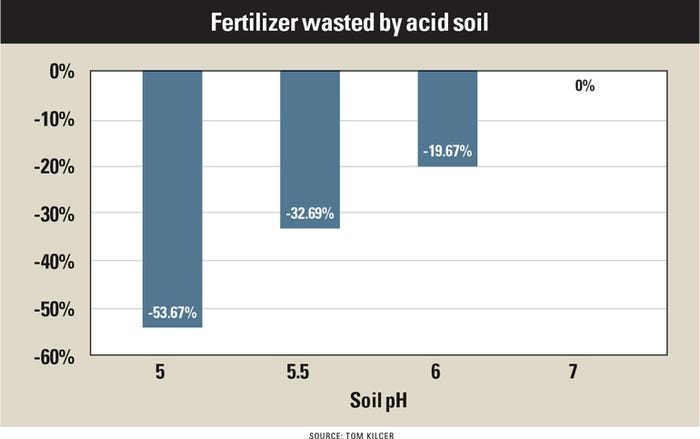December 6, 2021

The high cost of fertilizer has farmers in sticker shock and wondering how they will get crops fertilized next spring.
There are several steps you can take to help this situation, but let’s focus on two of them.
The first and most critical step is to put your money where it will give a return. What is needed in the field will vary tremendously from field to field and farm to farm. When a nutrient gets to a high or a very high level, the chance of getting a return by adding more fertilizer goes to nearly zero. It becomes a cost without a return.
You might think that you need fertilizer if you want top yield. That’s true, but if it is there already, adding more does nothing. The yield is then dependent on other nutrients, such as lime for pH, soil health and structure, and other management issues.
Get soil test done
If you have not gotten a soil test done in the past two years on every field you buy fertilizer for, then you are just guessing what nutrients are needed in the field. It is like driving through the field in a pickup truck and throwing money out the window.
Right now is a slow time for fieldwork, so you should consider doing one soon. Once you get the results, you can prioritize fields by nutrient content. Fields with high nutrient levels, most likely manured fields, can get by with a minimum starter. If phosphorus and potassium are high — which frequently occurs on fields where manure is spread daily — I have seen farms very successfully add 30 pounds of nitrogen as the corn starter and not apply any P or K. They had excellent yields.
A medium-test field will give optimum yield with much less fertilizer than a low-testing field because just pouring fertilizer on wastes money.
Correct your soil pH
What is ironic is that the fertilizer available to plants is optimized by having the correct pH, yet liming has been forgotten by many farmers.
Fertilizer prices are going up. Are you getting all the use of nutrients that you paid for? This isn’t about fertilizer suppliers shortchanging you. This is about you shortchanging your crops.
The biggest regulator of the return on your fertilizer investment is raising the pH to above 6.2 for corn or 7.0 for legumes. This is where fertilizer is most available and where plant growth can make the most use of it. As the pH drops, fertilizer efficiency can drop 30% to 50% in in some cases. Correct soil pH is a basic management principle for any farm manager who wants to run a profitable farm.
A few years back, I soil-sampled a very well-managed farm. We discovered the alfalfa fields had a pH level that was too low to grow corn well. Ironically, he was putting too much fertilizer on high-testing fields, to the point of hurting plant growth and tying up critical minor elements such as zinc. What he saved on fertilizer more than paid for the needed lime in one year!


Fields of 5.4-5.8 pH are common, especially on rented ground. As the charts above show, at these pH levels, you are throwing away a third of your fertilizer impact. Even at 6.0, nearly 20% is lost because of the acid soil’s effect on availability. In this era of high prices, correcting the soil pH first and then adding what fertilizer is needed will allow you to maximize the return on your crop.
The article "Starter Phosphorus for Corn" gives some very conservative guidelines to follow. Unless there is excessive P in the field, they usually recommend sufficient starter to meet crop removal. With very high prices and potential supply issues, it is suggested to just use starter N on high fields and mine some of the excess P to get you through next cropping season.
I haven’t talked about potassium, but that is important, too. Manure frequently contains as much potassium as nitrogen, and it doesn’t volatize, so it is available for the crop. In fact, 8,000 gallons of manure per acre often has enough potassium to equal 300 to 400 pounds per acre of potash fertilizer. The added factor is that there are several silty clay and clay soils that have a tremendous amount of potassium that can supply the crop. Tapping this supply can help you get high yields without breaking the bank.
As you reduce added nutrients, watch the amount of sulfur you have for protein formation.
Also, keep in mind that fields with very high phosphorus often have zinc deficiencies caused by too much P. An unbiased soil test can determine this for you.
Kilcer is a certified crop adviser in Kinderhook, N.Y.
About the Author(s)
You May Also Like




